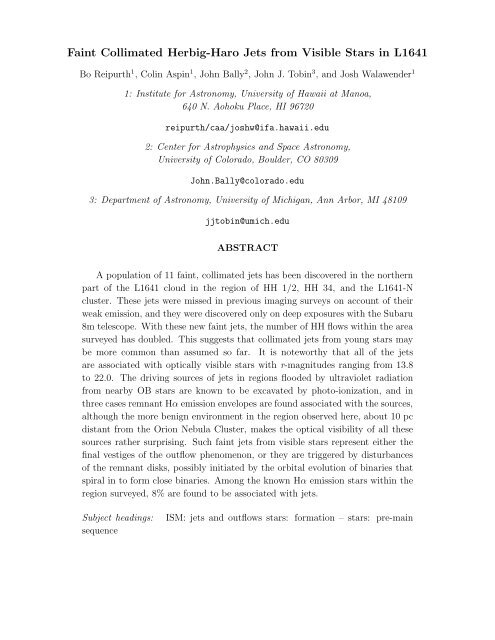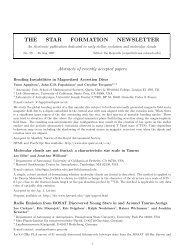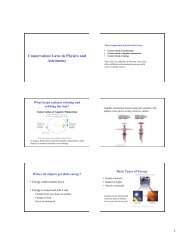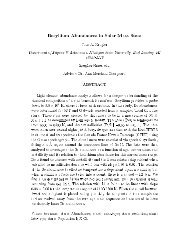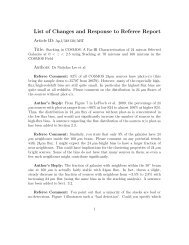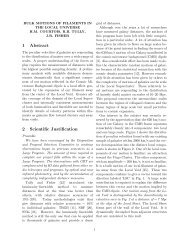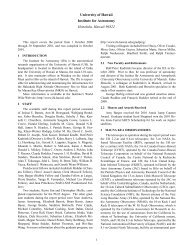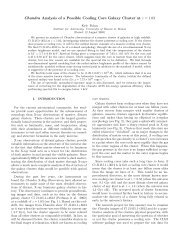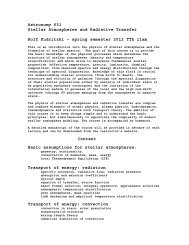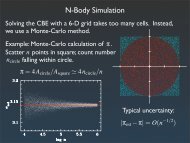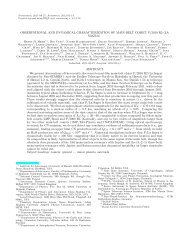Faint Collimated Herbig-Haro Jets from Visible Stars in L1641
Faint Collimated Herbig-Haro Jets from Visible Stars in L1641
Faint Collimated Herbig-Haro Jets from Visible Stars in L1641
You also want an ePaper? Increase the reach of your titles
YUMPU automatically turns print PDFs into web optimized ePapers that Google loves.
<strong>Fa<strong>in</strong>t</strong> <strong>Collimated</strong> <strong>Herbig</strong>-<strong>Haro</strong> <strong>Jets</strong> <strong>from</strong> <strong>Visible</strong> <strong>Stars</strong> <strong>in</strong> <strong>L1641</strong><br />
Bo Reipurth 1 , Col<strong>in</strong> Asp<strong>in</strong> 1 , John Bally 2 , John J. Tob<strong>in</strong> 3 , and Josh Walawender 1<br />
1: Institute for Astronomy, University of Hawaii at Manoa,<br />
640 N. Aohoku Place, HI 96720<br />
reipurth/caa/joshw@ifa.hawaii.edu<br />
2: Center for Astrophysics and Space Astronomy,<br />
University of Colorado, Boulder, CO 80309<br />
John.Bally@colorado.edu<br />
3: Department of Astronomy, University of Michigan, Ann Arbor, MI 48109<br />
jjtob<strong>in</strong>@umich.edu<br />
ABSTRACT<br />
A population of 11 fa<strong>in</strong>t, collimated jets has been discovered <strong>in</strong> the northern<br />
part of the <strong>L1641</strong> cloud <strong>in</strong> the region of HH 1/2, HH 34, and the <strong>L1641</strong>-N<br />
cluster. These jets were missed <strong>in</strong> previous imag<strong>in</strong>g surveys on account of their<br />
weak emission, and they were discovered only on deep exposures with the Subaru<br />
8m telescope. With these new fa<strong>in</strong>t jets, the number of HH flows with<strong>in</strong> the area<br />
surveyed has doubled. This suggests that collimated jets <strong>from</strong> young stars may<br />
be more common than assumed so far. It is noteworthy that all of the jets<br />
are associated with optically visible stars with r-magnitudes rang<strong>in</strong>g <strong>from</strong> 13.8<br />
to 22.0. The driv<strong>in</strong>g sources of jets <strong>in</strong> regions flooded by ultraviolet radiation<br />
<strong>from</strong> nearby OB stars are known to be excavated by photo-ionization, and <strong>in</strong><br />
three cases remnant Hα emission envelopes are found associated with the sources,<br />
although the more benign environment <strong>in</strong> the region observed here, about 10 pc<br />
distant <strong>from</strong> the Orion Nebula Cluster, makes the optical visibility of all these<br />
sources rather surpris<strong>in</strong>g. Such fa<strong>in</strong>t jets <strong>from</strong> visible stars represent either the<br />
f<strong>in</strong>al vestiges of the outflow phenomenon, or they are triggered by disturbances<br />
of the remnant disks, possibly <strong>in</strong>itiated by the orbital evolution of b<strong>in</strong>aries that<br />
spiral <strong>in</strong> to form close b<strong>in</strong>aries. Among the known Hα emission stars with<strong>in</strong> the<br />
region surveyed, 8% are found to be associated with jets.<br />
Subject head<strong>in</strong>gs: ISM: jets and outflows stars: formation – stars: pre-ma<strong>in</strong><br />
sequence
– 2 –<br />
1. Introduction<br />
The northern part of the <strong>L1641</strong> cloud is best known for harbor<strong>in</strong>g the Orion Nebula<br />
Cluster, but also of great <strong>in</strong>terest is the part of the cloud about a degree to the south, where<br />
low-mass star formation is abundant. Famous young stars like V380 Ori can be found here<br />
(<strong>Herbig</strong> 1960), as well as the embedded cluster <strong>L1641</strong>-N (Strom et al. 1989a), together<br />
with many dozens of Hα emission stars scattered across the cloud (<strong>Haro</strong> 1953, Parsamian<br />
& Chavira 1982, Wouterloot & Brand 1992, Wiramihardja et al. 1991) and many isolated<br />
embedded protostars (Strom et al. 1989b). As a result of this active production of stars, the<br />
cloud conta<strong>in</strong>s one of the highest known concentrations of <strong>Herbig</strong>-<strong>Haro</strong> (HH) flows, <strong>in</strong>clud<strong>in</strong>g<br />
such well-known objects as HH 1/2 (<strong>Herbig</strong> & Jones 1981) and HH 34 (Reipurth et al. 2002),<br />
as well as many molecular outflows (Fukui et al. 1986, Morgan & Bally 1991). A review<br />
of the properties of HH flows is given <strong>in</strong> Reipurth & Bally (2001), and an overview of star<br />
formation activity <strong>in</strong> the <strong>L1641</strong> cloud can be found <strong>in</strong> Allen & Davis (2008). In the follow<strong>in</strong>g<br />
we assume a distance to <strong>L1641</strong> similar to that of the ONC, which has been determ<strong>in</strong>ed to<br />
be 414 pc by Menten et al. (2007). For a thorough discussion of distance determ<strong>in</strong>ations to<br />
the ONC, see Muench et al. (2008).<br />
In this paper, we present a survey for new HH flows <strong>in</strong> the HH 1/2 and HH 34 region of<br />
the <strong>L1641</strong> cloud, us<strong>in</strong>g a set of very deep images through Hα and [SII] filters obta<strong>in</strong>ed at the<br />
8m Subaru telescope. Based on this material we have discovered 11 collimated jets, which<br />
are dist<strong>in</strong>guished <strong>from</strong> the other flows <strong>in</strong> the region by their weak emission and, <strong>in</strong> all cases,<br />
by emanat<strong>in</strong>g <strong>from</strong> visible stars (Table 1). In Section 2 we give details of the observations,<br />
<strong>in</strong> Section 3 we discuss the <strong>in</strong>dividual jets and their driv<strong>in</strong>g sources, and <strong>in</strong> Section 4 we<br />
consider the nature of this population of very fa<strong>in</strong>t collimated jets.<br />
2. Observations<br />
Exposures were made with the 8m Subaru telescope and SuprimeCam. A 5-po<strong>in</strong>t dither<br />
map with step size of 40 ′′ was used <strong>in</strong> order to cover the 17 ′′ gaps between the 10 <strong>in</strong>dividual<br />
CCDs. An Hα filter was used with a FWHM of 99 ˚A, central wavelength of 6596 ˚A, and<br />
peak transmission of 87%. The Hα image was obta<strong>in</strong>ed <strong>in</strong> clear conditions on UT Jan 4 2006<br />
with a total exposure time of 5 × 12 m<strong>in</strong> at airmass 1.15, result<strong>in</strong>g <strong>in</strong> images with FWHM<br />
of 0.9 ′′ . A [SII] filter was used with a FWHM of 130 ˚A, central wavelength of 6714 ˚A, and<br />
peak transmission of 87%. The [SII] image was obta<strong>in</strong>ed <strong>in</strong> clear conditions on UT Jan 5<br />
2006 with a total exposure time of 5 × 12 m<strong>in</strong> at airmass 1.22, and the see<strong>in</strong>g varied <strong>from</strong><br />
0.61 ′′ to 0.65 ′′ between exposures.
– 3 –<br />
The area surveyed is located <strong>in</strong> the northern part of the <strong>L1641</strong> cloud and covers an<br />
area of 30 ′ by 37 ′ approximately centered on the source of the giant HH 34 flow (Fig. 1).<br />
Specifically the field ranges <strong>in</strong> right ascension <strong>from</strong> 5:34:23 to 5:36:54 and <strong>in</strong> decl<strong>in</strong>ation <strong>from</strong><br />
–6:14 to –6:44 (2000 coord<strong>in</strong>ates).<br />
High-resolution (R∼35,000) spectra were obta<strong>in</strong>ed of the jet-driv<strong>in</strong>g sources us<strong>in</strong>g the<br />
multifiber Hectochelle spectrograph (Szentgyorgyi et al. 1998) on the 6.5m MMT. The<br />
chosen echelle order covers the wavelength range of ∼5150-5300 ˚A. The spectra were crosscorrelated<br />
with synthetic stellar spectra, as described <strong>in</strong> Tob<strong>in</strong> et al. (2009). Results are<br />
listed <strong>in</strong> Table 2.<br />
Infrared photometry of the jet sources was extracted <strong>from</strong> the 2MASS catalogue (Skrutskie<br />
et al. 2006) and <strong>from</strong> the Spitzer archive, and optical Sloan photometry (York et al.<br />
2000) was k<strong>in</strong>dly provided by M<strong>in</strong> Fang (see Fang et al. 2009).<br />
3. Results<br />
In the follow<strong>in</strong>g we describe the <strong>in</strong>dividual jets discovered and the known properties of<br />
their associated driv<strong>in</strong>g sources.<br />
3.1. HH 1020<br />
The HH 1020 jet is a f<strong>in</strong>ely collimated bipolar jet with asymmetrical lobes and a total<br />
extent of 134 ′′ (Fig. 2). The SE lobe is the most extensive, with a length of 123 ′′ and<br />
consist<strong>in</strong>g of numerous knots of vary<strong>in</strong>g brightness along the well def<strong>in</strong>ed flow axis at a PA<br />
of 130 ◦ . These knots are visible <strong>in</strong> both Hα and [SII], but are brighter <strong>in</strong> Hα. In contrast,<br />
the short NW lobe (with a measurable extent of only 11 ′′ ) is primarily emitt<strong>in</strong>g <strong>in</strong> [SII]. It is<br />
noteworthy that the jet is perpendicular to the filamentary clouds <strong>in</strong> the northwestern part<br />
of the <strong>L1641</strong> clouds.<br />
The source is the Hα emission star <strong>Haro</strong> 4-222 (<strong>Haro</strong> 1953) or PaCh 145 (Parsamian<br />
& Chavira 1982) 1 , or Kiso 76-103 (Wiramihardja et al. 1991), or WB 406 (Wouterloot &<br />
Brand 1992), also known as 2MASS J05343988-0625140. Carpenter et al. (2001) noted its<br />
variability <strong>in</strong> the near-<strong>in</strong>frared.<br />
1 Parsamian & Chavira (1982) erroneously identify <strong>Haro</strong> 4-222 = PaCh 145 as the neighbor<strong>in</strong>g flare star<br />
V766 Ori
– 4 –<br />
Approximately 20 ′′ SW of the source one f<strong>in</strong>ds the flare star V766 Ori. An optical light<br />
curve of V766 Ori is shown by Nicholson & Varley (2006). Our image shows that V766 Ori<br />
is actually a small triple system (Figs. 2 and 14) and given the low surface density of stars<br />
<strong>in</strong> this part of <strong>L1641</strong> it seems likely that <strong>Haro</strong> 4-222 forms what might be the 4th star of<br />
this small multiple system.<br />
The near-<strong>in</strong>frared colors of <strong>Haro</strong> 4-222 (Table 3) <strong>in</strong>dicate a substantial <strong>in</strong>frared excess.<br />
Spitzer clearly detected the source at all wavelengths out to 24 µm. The spectral energy<br />
distribution (SED) is shown <strong>in</strong> Figure 15a. We have used the Robitaille et al. (2006, 2007)<br />
models to fit the data, and show our best fit superposed on the data po<strong>in</strong>ts. The source<br />
appears to be a flat-spectrum object, between the Class I and II groups. The color-color<br />
diagrams <strong>in</strong> Figures 16 and 17 reflect this <strong>in</strong>termediate status. There is, however, one major<br />
difference between the observations and the model: the model requires an extensive envelope,<br />
which <strong>in</strong> the models is assumed to be spherically symmetric, and would produce an ext<strong>in</strong>ction<br />
of AV ∼7,000. Clearly this is not the case, as the source is a visible star, suggest<strong>in</strong>g that<br />
the envelope has developed <strong>in</strong>to a flattened structure, allow<strong>in</strong>g us to view the source <strong>in</strong> the<br />
optical.<br />
3.2. HH 1021<br />
The HH 1021 jet is very fa<strong>in</strong>t, and <strong>in</strong> addition to the jet the flow conta<strong>in</strong>s two fa<strong>in</strong>t, more<br />
distant, knots. The flow is significantly curved (Fig. 3), with an overall length of 84 ′′ . The<br />
jet and two knots are visible <strong>in</strong> both Hα and [SII], with approximately the same brightness<br />
<strong>in</strong> the two filters. No trace of a counterflow is seen.<br />
The source is a b<strong>in</strong>ary, with a companion at a separation of 3.4 ′′ and a PA of 233 ◦<br />
(Figs. 3 and 14). The jet appears to emanate <strong>from</strong> the brighter component to the NE.<br />
The source was one of the first variables to be found near the Orion Nebula (Picker<strong>in</strong>g<br />
& Leavitt 1904) and is now known as the flare star BW Ori or Parenago 1669 (Parenago<br />
1954). It was found to display Hα <strong>in</strong> emission <strong>in</strong> several surveys and is known as <strong>Haro</strong> 4-219<br />
(<strong>Haro</strong> 1953) or PaCh 173 (Parsamian & Chavira 1982) or Kiso 76-118 (Wiramihardja et al.<br />
1991).<br />
The SED of the source seen <strong>in</strong> Figure 15b and the color-color diagrams <strong>in</strong> Figures 16<br />
and 17 suggest that the source is a classical T Tauri star with an <strong>in</strong>frared excess that is<br />
modest except at 24 µm.
– 5 –<br />
3.3. HH 1022<br />
The HH 1022 jet is the shortest of the flows described <strong>in</strong> this study, and consists of a<br />
s<strong>in</strong>gle elongated knot at PA 250 ◦ reach<strong>in</strong>g a distance of 5 ′′ <strong>from</strong> the source (Fig. 4). The jet<br />
is only visible <strong>in</strong> the [SII] image, <strong>in</strong>dicat<strong>in</strong>g that it is of exceptionally low excitation.<br />
The source, which is located just 2.5 ′ west of the prom<strong>in</strong>ent HH 34 jet, is known as the<br />
Hα emission star <strong>Haro</strong> 4-224 = PaCh 248 = Kiso 76-153 (<strong>Haro</strong> 1953, Parsamian & Chavira<br />
1982, Wiramihardja et al. 1991). It is variable <strong>in</strong> the <strong>in</strong>frared (Carpenter et al. 2001).<br />
The 2MASS colors <strong>in</strong>dicate that HH 1022 IRS is a Class II source with hardly any<br />
redden<strong>in</strong>g or <strong>in</strong>frared excess, but an excess is detected <strong>in</strong> the mid-<strong>in</strong>frared (Figure 15c). The<br />
Spitzer colors are consistent with a Class II source (Figures 16 and 17).<br />
3.4. HH 1023<br />
The HH 1023 flow is a f<strong>in</strong>ely collimated bipolar jet with a total extent of 16 ′′ . The NE<br />
lobe is shorter (5.5 ′′ ), with well def<strong>in</strong>ed knots at a PA of 64 ◦ , brighter, and dom<strong>in</strong>ant <strong>in</strong> [SII].<br />
The SW lobe is longer (10.5 ′′ ), substantially fa<strong>in</strong>ter, with about the same brightness <strong>in</strong> Hα<br />
and [SII].<br />
The source is a visible star, which is detected <strong>in</strong> the near-<strong>in</strong>frared as 2MASS J05355651-<br />
0624122. It forms part of a small group<strong>in</strong>g of stars that <strong>in</strong>cludes <strong>Haro</strong> 4-386, an emission-l<strong>in</strong>e<br />
star which our images show is a b<strong>in</strong>ary with a separation of 1.3 ′′ (Fig. 5). Noth<strong>in</strong>g is known<br />
about the bright star just north of HH 1023 IRS.<br />
The 2MASS photometry suggests almost no redden<strong>in</strong>g and no near-<strong>in</strong>frared excess<br />
(Figure 15d), but an <strong>in</strong>frared excess picks up at mid-<strong>in</strong>frared wavelengths, <strong>in</strong>dicat<strong>in</strong>g that<br />
HH 1023 IRS may be surrounded by a disk with an <strong>in</strong>ner gap. The model shown assumes<br />
an envelope with high ext<strong>in</strong>ction, so this is another case where the envelope clearly cannot<br />
be spherical. The position of HH 1023 IRS <strong>in</strong> color-color diagrams suggests that it is a<br />
border-l<strong>in</strong>e Class I source (Figs. 16 and 17).<br />
3.5. HH 1024<br />
The HH 1024 flow is highly asymmetric, with a fa<strong>in</strong>t, collimated northern lobe about<br />
33 ′′ <strong>in</strong> extent at a PA of 6 ◦ , and a southern lobe that consists of a s<strong>in</strong>gle, large and bright<br />
knot, 4 ′′ <strong>from</strong> the source. The northern lobe shows dist<strong>in</strong>ct wiggl<strong>in</strong>g (Fig. 6).
– 6 –<br />
The source is an anonymous star, which has not drawn any previous attention. It is<br />
among the optically fa<strong>in</strong>test of the stars discussed here. The 2MASS colors do not <strong>in</strong>dicate<br />
much near-<strong>in</strong>frared excess, and the IRAC-photometry suggests a Class II source (Figure 16),<br />
but a strong excess is seen at 24 µm, which suggests a Class I source (Figure 17). The overall<br />
SED <strong>in</strong> Figure 15e <strong>in</strong>dicates a significant envelope, which must be flattened <strong>in</strong> order for the<br />
star to be visible.<br />
3.6. HH 1025<br />
The HH 1025 jet is a f<strong>in</strong>ely collimated bipolar jet located just west of the bright <strong>Herbig</strong>-<br />
<strong>Haro</strong> object HH 3 (for a general view of the region, see Reipurth 1985). The NE lobe is<br />
shorter, with a total extent of 25 ′′ , start<strong>in</strong>g out at a PA of 36 ◦ , but after 13 ′′ the jet shows a<br />
dist<strong>in</strong>ct bend <strong>in</strong> the flow axis. The SW lobe is perfectly straight and much longer, total<strong>in</strong>g<br />
an extent of 65 ′′ (Fig. 7).<br />
The driv<strong>in</strong>g source is the well known variable star AV Ori (HBC 159 = <strong>Haro</strong> 4-236<br />
= Parenago 2312), which has a fa<strong>in</strong>ter companion 5.9 ′′ to the NW at a PA of 303 ◦ , called<br />
AV Ori/c by Cohen & Kuhi (1979), who found it to be an emission l<strong>in</strong>e star; the companion<br />
is also known as HBC 481 (<strong>Herbig</strong> & Bell 1988). The irregular variability of AV Ori has<br />
been documented by Wolf (1903), Picker<strong>in</strong>g & Leavitt (1904), and Grank<strong>in</strong> et al. (2007),<br />
among others. AV Ori was detected <strong>in</strong> surveys for Hα emission l<strong>in</strong>e stars by <strong>Haro</strong> (1953),<br />
Wiramihardja et al. (1991), and Wouterloot & Brand (1992). Low-dispersion spectroscopy<br />
by Cohen & Kuhi (1979) suggests a spectral type of K4e, and Allen (1995) lists it as K5. The<br />
star was also detected <strong>in</strong> X-rays by Pravdo & Angel<strong>in</strong>i (1993). Us<strong>in</strong>g 2MASS and Spitzer<br />
photometry, Fang et al. (2009) determ<strong>in</strong>ed a lum<strong>in</strong>osity (their source #56) of 3.8 L⊙ and<br />
an ext<strong>in</strong>ction of 2.2 magnitudes. The SED <strong>in</strong> Figure 15f suggests a modest <strong>in</strong>frared excess<br />
ma<strong>in</strong>ly at longer wavelengths. The star is evidently a Class II source (Figures 16 and 17).<br />
3.7. HH 1026<br />
The HH 1026 jet is a highly collimated flow with a total extent of 128 ′′ (Fig. 8). A few<br />
very fa<strong>in</strong>t knots extend on either side of the driv<strong>in</strong>g source. The northern lobe term<strong>in</strong>ates <strong>in</strong><br />
a fa<strong>in</strong>t bow shock 46 ′′ <strong>from</strong> the source. A group of fa<strong>in</strong>t anonymous HH knots resembl<strong>in</strong>g an<br />
extended bow shock are located about 3 arcm<strong>in</strong> north of the source along the flow axis, but<br />
it is unclear whether they are related to the HH 1026 flow. The southern lobe, <strong>in</strong> contrast,<br />
displays a bright segment 10 ′′ long start<strong>in</strong>g 53 ′′ <strong>from</strong> the source, and term<strong>in</strong>ates <strong>in</strong> a bow
– 7 –<br />
shock 105 ′′ <strong>from</strong> the source. The driv<strong>in</strong>g source, which is among the optically fa<strong>in</strong>test of the<br />
sources discussed here, shows elongation <strong>in</strong> the direction of the flow, but other than that<br />
noth<strong>in</strong>g is known about it, it has not drawn any attention <strong>in</strong> any other survey, <strong>in</strong> particular it<br />
is not <strong>in</strong>cluded <strong>in</strong> the 2MASS catalogue. The nearest 2MASS source is J05360665-0632171,<br />
which is a bright (r∼15.2) visible star 53 ′′ to the SE.<br />
The available optical and Spitzer photometry shows a ris<strong>in</strong>g SED (Figure 15g), and<br />
the Spitzer colors (Figures 16 and 17) are consistent with a Class I source with a significant<br />
envelope. Aga<strong>in</strong>, the optical visibility, although fa<strong>in</strong>t, suggests that the envelope is flattened.<br />
3.8. HH 1027<br />
The HH 1027 jet is a well collimated flow, albeit asymmetric and somewhat perturbed<br />
(Fig. 9). It is seen only <strong>in</strong> [SII], and has a total extent of 2.5 ′ , with a northern irregular<br />
lobe extend<strong>in</strong>g over 22 ′′ , and a southern slightly curved lobe extend<strong>in</strong>g 128 ′′ . The source is<br />
optically fa<strong>in</strong>t, but is weakly detected <strong>in</strong> the near-<strong>in</strong>frared as 2MASS J05361960-0636171.<br />
The SED of the driv<strong>in</strong>g source shows no evidence for circumstellar material (Figure 15h).<br />
This is the only one among the 11 jet sources discussed here that is not detected at 24 µm.<br />
The Spitzer IRAC colors are consistent with a Class III source. It is noteworthy that the<br />
referee of this paper has found two fan-shaped cavities <strong>in</strong> deep H2 images close to, but not<br />
exactly on, the axis of the poorly def<strong>in</strong>ed southern end of the HH 1027 jet. Further work is<br />
required to determ<strong>in</strong>e whether this could be evidence for an alternative jet source, or it is<br />
an unrelated young star.<br />
3.9. HH 1028<br />
The HH 1028 jet has a s<strong>in</strong>gle well collimated lobe with many fa<strong>in</strong>t (primarily Hα emitt<strong>in</strong>g)<br />
knots extend<strong>in</strong>g 58 ′′ to the SW at a PA of 231 ◦ , where two bright [SII]-dom<strong>in</strong>ant knots<br />
are located (Fig. 10). More knots are found further to the SW, but not precisely on the<br />
flow axis, so their provenance is unknown (see Fig. 11). The flow is located <strong>in</strong> the outskirts<br />
of the embedded <strong>L1641</strong>-N cluster, and is driven by the variable star V584 Ori. Hodapp &<br />
Deane (1993) obta<strong>in</strong>ed an <strong>in</strong>frared spectrum of the star (their source #45), show<strong>in</strong>g weak<br />
absorption l<strong>in</strong>es of Na, Ca, and CO, <strong>in</strong>dicat<strong>in</strong>g a spectral type of K5. No Brγ absorption<br />
was seen. Galfalk & Olofsson (2008) suggest a spectral type of K6, and Allen (1995) suggests<br />
M0.5, both <strong>from</strong> optical spectroscopy. The star is listed as <strong>Haro</strong> 4-214 = PaCh 401<br />
= Kiso 76-268 <strong>in</strong> the Hα emission star catalogues of <strong>Haro</strong> (1953), Parsamian & Chavira
– 8 –<br />
(1982), and Wiramihardja et al. (1991), respectively. Fang et al. (2009) classifies the star<br />
(their source #118) as a weak-l<strong>in</strong>e T Tauri star. V584 Ori was <strong>in</strong>cluded <strong>in</strong> the large <strong>in</strong>frared<br />
variability survey of Carpenter et al. (2001).<br />
The 2MASS colors <strong>in</strong>dicate a significant <strong>in</strong>frared excess, and the SED shows that this<br />
extends <strong>in</strong>to the mid-<strong>in</strong>frared (Figure 15i). The Spitzer colors are consistent with a Class II<br />
source (Figures 16 and 17).<br />
3.10. HH 1029<br />
The HH 1029 flow is a f<strong>in</strong>ely collimated jet stretch<strong>in</strong>g across 2 arcm<strong>in</strong> (Fig. 11). It<br />
is already known at <strong>in</strong>frared wavelengths, where it consists of two fa<strong>in</strong>t H2 emission knots<br />
(these are called SMZ 5-20 and 5-22 <strong>in</strong> Stanke et al. 1998, their Figure 1). The <strong>in</strong>frared flow<br />
is labeled as SMZ 54 <strong>in</strong> Stanke, McCaughrean, Z<strong>in</strong>necker (2002), and is also seen <strong>in</strong> the H2<br />
images of Galfalk & Olofsson (2007). In the optical the flow is po<strong>in</strong>t<strong>in</strong>g straight back to a<br />
nebulous star, variously known as <strong>Haro</strong> 4-403 (Parsamian & Chavira 1982), Re 40 (Reipurth<br />
1985), and Kiso 76-258 (Wiramihardja et al. 1991). No other source is found along the flow<br />
axis <strong>in</strong> the Spitzer images of this region. The <strong>in</strong>sert <strong>in</strong> Figure 11 shows that the star is fa<strong>in</strong>tly<br />
visible at optical wavelengths, and is surrounded by a large disk shadow, suggest<strong>in</strong>g that the<br />
disk is nearly edge-on. The flow is at a position angle of 132 ◦ , which is perpendicular to the<br />
disk shadow. Close to the star two very fa<strong>in</strong>t and highly collimated jets are seen emanat<strong>in</strong>g<br />
<strong>from</strong> the bipolar reflection nebula, the one to the SE is more pronounced and seen <strong>in</strong> both<br />
the Hα and [SII] images, whereas the one to the NW is only barely visible <strong>in</strong> the [SII] image.<br />
If one follows the well def<strong>in</strong>ed flow axis of the HH 1029 flow <strong>from</strong> the source to the NW<br />
one comes to an already known object, HH 298A (Reipurth et al. 1998a), located along the<br />
flow axis and at the same distance to the source as the first bright knot <strong>in</strong> the HH 1029 jet.<br />
This strongly suggests that HH 298A is a part of the counterflow to HH 1029. Two fa<strong>in</strong>ter,<br />
diffuse knots (HH 298B and C) are found to the east of HH 298A, not on the well-def<strong>in</strong>ed<br />
flow axis; <strong>in</strong> view of the likely association between HH 298A and HH 1029, it is unclear<br />
whether the knots B and C are related to A. The total extent of the HH 298/HH 1029 flow<br />
is about 366 arcsec, which at the assumed distance of 414 pc corresponds to about 0.75 pc,<br />
mak<strong>in</strong>g this flow the largest of the 11 jets discussed <strong>in</strong> this paper.<br />
The SED of the source shows an <strong>in</strong>frared excess, especially at 24 µm (Figure 15j). The<br />
Spitzer colors suggest that the star is a Class II source (Figures 16 and 17).
– 9 –<br />
3.11. HH 1030<br />
The HH 1030 flow is a highly collimated bipolar jet, with a prom<strong>in</strong>ent southern lobe<br />
conta<strong>in</strong><strong>in</strong>g dozens of closely spaced knots that stretches over 67 ′′ . The northern lobe is less<br />
dist<strong>in</strong>ct and term<strong>in</strong>ates <strong>in</strong> an isolated bow shock 90 ′′ <strong>from</strong> the source (Fig. 12). The two<br />
lobes deviate <strong>from</strong> a common straight l<strong>in</strong>e. Whereas the northern lobe is brighter <strong>in</strong> Hα, the<br />
southern lobe is dom<strong>in</strong>ant <strong>in</strong> [SII]. At the location of the brightest knot, the southern lobe<br />
slightly changes direction; we cannot exclude the possibility that this could be a separate<br />
flow with an as yet unidentified source.<br />
The source is the variable star V585 Ori that is also an Hα emission l<strong>in</strong>e star known as<br />
<strong>Haro</strong> 4-227 = PaCh 410 = Kiso 76-274 (<strong>Haro</strong> 1953, Parsamian & Chavira 1982, Wiramihardja<br />
et al. 1991). Allen (1995) suggests a spectral type of K8. Fang et al. (2009) classifies the<br />
star (their object #131) as a classical T Tauri star with an ext<strong>in</strong>ction of 3.9 magnitudes.<br />
Our images show a companion at a separation of 4.3 ′′ <strong>in</strong> PA 202 ◦ (Figs. 12 and 14). Our<br />
Hectochelle spectrum of the 5150–5300 ˚A region shows a rich emission l<strong>in</strong>e spectrum (Fig. 13),<br />
with the follow<strong>in</strong>g rather prom<strong>in</strong>ent l<strong>in</strong>es (a colon <strong>in</strong>dicates a probable classification).<br />
FeII 5169.85 (42) (blended with MgI 5167.32/5172.68 (2):)<br />
MgI 5183.60 (2):<br />
FeII 5197.57 (49)<br />
FeII 5234.62 (49)<br />
CaI 5270.27 (22):<br />
FeII 5275.99 (49)<br />
FeII 5284.09 (41)<br />
Comparison with high-resolution spectra of active T Tauri stars k<strong>in</strong>dly provided by<br />
George H. <strong>Herbig</strong> shows that this spectral region is often rich <strong>in</strong> emission l<strong>in</strong>es of iron, but<br />
with greatly vary<strong>in</strong>g strengths and ratios depend<strong>in</strong>g on the temperature of the l<strong>in</strong>e emitt<strong>in</strong>g<br />
region. The emission spectrum of V585 Ori shows a remarkable similarity to that of DG Tau,<br />
which is also known to drive a collimated jet (e.g. Bacciotti et al. 2000).<br />
The 2MASS photometry <strong>in</strong>dicates a substantial <strong>in</strong>frared excess, which cont<strong>in</strong>ues <strong>in</strong>to<br />
the mid-<strong>in</strong>frared (Figure 15k). The Spitzer colors are consistent with the star be<strong>in</strong>g a Class II<br />
source (Figures 16 and 17).
– 10 –<br />
4. Discussion<br />
4.1. Statistics of HH <strong>Jets</strong> <strong>in</strong> <strong>L1641</strong><br />
The rich population of HH flows <strong>in</strong> the northern part of <strong>L1641</strong> offers an opportunity<br />
to do some statistical estimates of the frequency of HH flows. With<strong>in</strong> the Subaru image a<br />
number of HH flows are already known. Several of these are giant, parsec-scale flows, and as<br />
flows that were previously assumed to be <strong>in</strong>dependent are found to belong as components of<br />
a giant flow, the number of HH flows <strong>in</strong> the region has dim<strong>in</strong>ished. Examples are the well<br />
collimated HH 33/40 and HH 85 flows, which are now seen merely as part of the giant HH<br />
34 jet complex. We have counted the number of <strong>in</strong>dependent HH flows <strong>in</strong> the Subaru field,<br />
and f<strong>in</strong>d 8 flows that either have well def<strong>in</strong>ed driv<strong>in</strong>g sources, or cannot be associated with<br />
a known giant flow. These flows are 1) the giant HH 34 jet complex (<strong>in</strong>clud<strong>in</strong>g HH 33/40,<br />
85, 86, 87, 88, 327), 2) the giant HH 401 bow shock associated with HH 1/2/3, 3) the giant<br />
HH 35/HH 222 flow <strong>from</strong> V380 Ori, and 4-8) a group of HH flows emanat<strong>in</strong>g <strong>from</strong> sources<br />
<strong>in</strong> the <strong>L1641</strong>-N cluster: HH 299, HH 301/302, HH 303, HH 304, and HH 305. A number<br />
of fa<strong>in</strong>t additional HH shocks are found <strong>in</strong> the Subaru images, but most or all are likely to<br />
belong to one of the various giant HH flows cross<strong>in</strong>g the region, although we cannot exclude<br />
the possibility that future proper motion studies will reveal additional <strong>in</strong>dependent flows.<br />
Unless the <strong>L1641</strong> region is somehow atypical, the discovery of 11 new, fa<strong>in</strong>t HH jets<br />
<strong>in</strong>dicates that HH flows may be significantly more common, by a factor of about 2, than<br />
hitherto assumed.<br />
4.2. Nature and Orig<strong>in</strong> of the Driv<strong>in</strong>g Sources<br />
Whereas the driv<strong>in</strong>g sources of the 8 previously known HH flows with<strong>in</strong> the Subaru field<br />
are mostly embedded <strong>in</strong>frared sources without optical counterparts, all of the 11 new flow<br />
sources are visible stars.<br />
Robitaille et al. (2007) have presented a large set of star/disk/envelope models, which<br />
we used <strong>in</strong> Section 3 to characterize the environment of the <strong>in</strong>dividual sources 2 . All the<br />
sources have one th<strong>in</strong>g <strong>in</strong> common, namely that they are visible <strong>in</strong> the optical, rang<strong>in</strong>g <strong>from</strong><br />
bright (r∼13.8) to fa<strong>in</strong>t (r∼22.0). But the SEDs and the locations <strong>in</strong> color-color diagrams<br />
reveal a wide range <strong>in</strong> circumstellar properties of the sources, <strong>from</strong> Class I sources to Class III<br />
2 These models were derived us<strong>in</strong>g the spectral energy distribution fitt<strong>in</strong>g tool at<br />
http://caravan.astro.wisc.edu/protostars/
– 11 –<br />
sources. In the follow<strong>in</strong>g we attempt to understand this range of properties.<br />
It is well known that some visible T Tauri stars are associated with HH jets, which <strong>in</strong><br />
certa<strong>in</strong> cases can be quite bright. Examples <strong>in</strong>clude RW Aur (Melnikov et al. 2009), DG<br />
Tau (Bacciotti et al. 2000), HL Tau (Mundt et al. 1990), and V510 Ori (Reipurth et al.<br />
1998b).<br />
There are <strong>in</strong> pr<strong>in</strong>ciple three ways for a T Tauri star to transit <strong>from</strong> an embedded <strong>in</strong>frared<br />
source to an optically visible star. First, it may excavate itself through its outflow activity,<br />
blow<strong>in</strong>g away the remnants of its nascent cloud core (Lada & Shu 1990). Second, the star may<br />
be flung away <strong>from</strong> its core by dynamical <strong>in</strong>teractions <strong>in</strong> a small multiple system (Reipurth<br />
2000). And third, the environment of the star may be ablated by the presence of a nearby<br />
OB star (Reipurth et al. 1998b).<br />
The region of the <strong>L1641</strong> cloud that we are focus<strong>in</strong>g on here is far removed <strong>from</strong> the OB<br />
stars at the center of the Orion Nebula Cluster, so they are likely to be affected by only a<br />
rather benign ultraviolet radiation field. This leaves the other two possibilities to expla<strong>in</strong><br />
the visibility of all these jet sources.<br />
In favor of the first case, we note that at the end of the outflow phase the sources are<br />
much more likely to be visible than earlier, because the <strong>in</strong>fall<strong>in</strong>g envelope is close to be<strong>in</strong>g<br />
depleted and the cavity dug by the outflow activity may have gradually widened. Also, the<br />
very low surface brightness of the new jets suggests weak shocks, which conceivably could<br />
be related to a decl<strong>in</strong>e <strong>in</strong> the function<strong>in</strong>g or feed<strong>in</strong>g of the jet eng<strong>in</strong>e. F<strong>in</strong>ally, the fact that<br />
almost all of the jet sources have substantial <strong>in</strong>frared excesses could <strong>in</strong>dicate that they are<br />
less evolved than the average visible T Tauri star <strong>in</strong> the region. In short, the discovery of<br />
a population of visible stars with very fa<strong>in</strong>t jets can be reconciled with our current view of<br />
the evolution of young stars.<br />
The second case, however, also has appeal<strong>in</strong>g aspects. We note that some of the sources<br />
discussed here have spectral energy distributions typical of Class I sources, which are generally<br />
not optically visible, but may become visible <strong>in</strong> the follow<strong>in</strong>g manner. Triple and<br />
higher-order multiple systems are born <strong>in</strong> a non-hierarchical configuration, and dynamically<br />
evolve <strong>in</strong>to a hierarchical form through close <strong>in</strong>teractions. Usually it is the lightest component<br />
that is ejected <strong>in</strong>to a distant orbit or is altogether freed. The rema<strong>in</strong><strong>in</strong>g pair forms a<br />
new b<strong>in</strong>ary, and because the b<strong>in</strong>ary frequently has a high eccentricity, it evolves viscously<br />
as the circumstellar material of the components <strong>in</strong>teract. Dur<strong>in</strong>g the <strong>in</strong>creas<strong>in</strong>gly close and<br />
<strong>in</strong>creas<strong>in</strong>gly frequent periastron passages, accretion is enhanced, lead<strong>in</strong>g to outflow activity.<br />
<strong>Herbig</strong>-<strong>Haro</strong> jets thus can be <strong>in</strong>terpreted as the fossil record of the early evolution of a newborn<br />
b<strong>in</strong>ary (Reipurth 2000). If <strong>in</strong>terpreted with<strong>in</strong> this scenario, the 11 jet sources should be
– 12 –<br />
unresolved close b<strong>in</strong>aries (∼10 AU), and <strong>in</strong> addition to the above processes, their visibility<br />
may be aided by the b<strong>in</strong>ary recoil<strong>in</strong>g out of its cloud core by the dynamical <strong>in</strong>teractions with<br />
a third component. This third component may be <strong>in</strong> a bound orbit less than a few hundred<br />
AU <strong>in</strong> size, and thus only visible through adaptive optics observations. Or it may be <strong>in</strong> a<br />
larger orbit, and resolvable with our images. We note that four of the 11 sources are associated<br />
with a visible companion or multiple system. F<strong>in</strong>ally, <strong>in</strong> some cases the ejection event<br />
may have led to an unbound system and the third component may have left the system.<br />
A more detailed study of the 11 driv<strong>in</strong>g sources is required to cast light on whether such<br />
dynamical <strong>in</strong>teractions have perhaps aided some of them, <strong>in</strong> particular the Class I sources,<br />
to become visible.<br />
4.3. How Common are <strong>Jets</strong> dur<strong>in</strong>g the T Tauri stage?<br />
We now estimate what fraction of visible T Tauri stars are associated with HH jets.<br />
The 30 ′ × 37 ′ region <strong>in</strong> northern <strong>L1641</strong> imaged with the Subaru telescope for this study is<br />
fully covered by the major, deep survey for Hα emission stars by Pettersson, Armond, &<br />
Reipurth (2011). Their list conta<strong>in</strong>s 99 Hα emission stars with<strong>in</strong> that field. All 11 new jets<br />
have well identified visible driv<strong>in</strong>g sources and among those, 7 are <strong>in</strong>cluded <strong>in</strong> the Pettersson<br />
et al. catalog (the rest presumably be<strong>in</strong>g fa<strong>in</strong>ter than the detection limit of the Pettersson<br />
et al. survey). One more of the 99 stars of Petterson et al. is associated with a jet, HH 305,<br />
namely a fa<strong>in</strong>ter companion to the young variable PR Ori (Reipurth et al. 1998a, also see<br />
Fig. 1). Altogether, it appears that ∼8% of visible Hα emitters have jets at any given time.<br />
In other words, the presence of a physically resolved jet (as opposed to be<strong>in</strong>g associated with<br />
unresolved shocked emission) occurs only for a very small subset of young visible stars at any<br />
given time. This is consistent with the general f<strong>in</strong>d<strong>in</strong>g that most jet energy sources are still<br />
deeply embedded <strong>in</strong> their placental material and thus detectable only as <strong>in</strong>frared sources.<br />
4.4. Hα Envelopes <strong>in</strong> Northern <strong>L1641</strong><br />
Three of the jet sources discussed here have small, fa<strong>in</strong>t envelopes visible only <strong>in</strong> Hα<br />
but not <strong>in</strong> [SII], <strong>in</strong>dicat<strong>in</strong>g that these are not simply compact reflection nebulae. We have<br />
searched for further of these Hα envelopes around other stars <strong>in</strong> this field and have found a<br />
total of eight such objects, which are listed <strong>in</strong> Table 4.<br />
All of these objects are on the western side of the Subaru image and have similar<br />
surface brightness <strong>in</strong> Hα. Several of these objects (No. 1 - <strong>Haro</strong> 4-222 / HH 1020 and No.
– 13 –<br />
2 - BW Ori / HH 1021) are located more than a parsec west of the western edge of the<br />
Orion A molecular cloud <strong>in</strong> a region nearly devoid of molecular gas. The Hα emission is<br />
limb-brightened <strong>in</strong> several of the objects, <strong>in</strong>clud<strong>in</strong>g No. 1 and No. 8 and possibly No. 5.<br />
The central stars tend to be located towards the north rim of the envelopes. The radii of<br />
these objects range <strong>from</strong> about 2 ′′ to 8 ′′ (∼800 to 3200 AU).<br />
The relatively similar surface brightness, limb-brighten<strong>in</strong>g, location on the western side<br />
of the Orion A molecular cloud, and displacement of the central stars towards the north<br />
suggest that the Hα emission traces ionization fronts surround<strong>in</strong>g compact neutral globules<br />
conta<strong>in</strong><strong>in</strong>g young stars. These objects have dimensions comparable to the largest proplyds<br />
observed <strong>in</strong> the outskirts of the Orion Nebula such as the ”Beehive Proplyd” (Bally et al.<br />
2005, Smith et al. 2005). They may be exposed to the ioniz<strong>in</strong>g Lyman cont<strong>in</strong>uum radiation<br />
which permeates the <strong>in</strong>terior of the Orion super-bubble and which ionizes Barnard’s Loop <strong>in</strong><br />
the east and the Eridanus Loop <strong>in</strong> the west (see Bally 2008 for an overview). Some of this<br />
radiation may orig<strong>in</strong>ate <strong>from</strong> massive stars <strong>in</strong> the Orion Nebula that escapes along densitybounded<br />
portions of the nebula; the rest may come <strong>from</strong> massive stars distributed <strong>in</strong> the<br />
extended OB association.<br />
Nearly one-half of the stars with such Hα envelopes power outflows. The envelopes<br />
<strong>in</strong>dicate the presence of extended reservoirs of gas surround<strong>in</strong>g these young stars. However,<br />
only about 5% of the young stars <strong>in</strong> the region under study exhibit Hα envelopes.<br />
These envelopes may trace circumstellar material that has survived until now despite<br />
be<strong>in</strong>g <strong>in</strong> an ioniz<strong>in</strong>g environment. A crude estimate of the expected mass-loss rate due to<br />
photo-ablation can be obta<strong>in</strong>ed by assum<strong>in</strong>g that a spherical cloud of radius r is illum<strong>in</strong>ated<br />
by a Lyman cont<strong>in</strong>uum radiation field of lum<strong>in</strong>osity Q at a distance D. It is assumed that<br />
the cloud is sufficiently dense to rema<strong>in</strong> neutral and that its gas is stationary. Assume that<br />
at the cloud surface, photo-ablated gas is accelerated to a constant speed C ≈ 10 km s −1<br />
by the heat<strong>in</strong>g effect of the ioniz<strong>in</strong>g radiation and that <strong>in</strong> the steady state, the flow forms a<br />
spherically divergent w<strong>in</strong>d with ˙ M = fπr 2 µmHn(r)C where f is a geometric factor close to<br />
one, µ is the mean molecular weight, mH is the mass of hydrogen, and n(r) is the number<br />
density <strong>in</strong> the flow at radius r. The density <strong>in</strong> such a w<strong>in</strong>d decreases as n(r) = n(rI)(rI/r) 2<br />
where rI is the radius of the ionization front (e.g. the radius of the dense and neutral<br />
cloud) and n(rI) is the electron density just outside this front after it has been accelerated<br />
to a velocity C. This electron density is regulated by recomb<strong>in</strong>ations occurr<strong>in</strong>g with<strong>in</strong> the<br />
diverg<strong>in</strong>g ionized w<strong>in</strong>d ablat<strong>in</strong>g <strong>from</strong> the cloud. Integrat<strong>in</strong>g the recomb<strong>in</strong>ation rate per unit<br />
volume, n 2 (r)αB, <strong>from</strong> the ionization front to <strong>in</strong>f<strong>in</strong>ity, sett<strong>in</strong>g this equal to the ioniz<strong>in</strong>g flux,<br />
and solv<strong>in</strong>g for the electron density at the front gives ne(rI) = (3Q/4παBrI) 1/2 1/D. Here,<br />
αB = 2.6 × 10 −13 is the case-B recomb<strong>in</strong>ation coefficient for hydrogen.
– 14 –<br />
For Q = 10 49 ioniz<strong>in</strong>g photons per second and assum<strong>in</strong>g D = 10 pc (the Orion Nebula<br />
is located at a projected distance of about 6 to 7 pc north of this field), and adopt<strong>in</strong>g<br />
r = 3 × 10 16 cm, one derives an electron density just outside of the ionization front of ne ≈<br />
600 cm −3 . The result<strong>in</strong>g peak emission measure is EM = � n 2 2 dl ≈ 3 × 103 cm −6 pc (which<br />
arises at the projected edge of the cloud), correspond<strong>in</strong>g to a peak Hα surface brightness of<br />
I(Hα) = 7 × 10 −15 erg s −1 cm −2 arcsec −2 . This is an upper bound s<strong>in</strong>ce only attenuation of<br />
Lyman cont<strong>in</strong>uum by photo-ablation flow <strong>from</strong> the cloud has been considered; other dust or<br />
gas between the UV source and the cloud has been ignored. Furthermore, foreground dust<br />
will also dim<strong>in</strong>ish the Hα surface brightness. These numbers are consistent with the observed<br />
brightness of the objects <strong>in</strong> the images. The result<strong>in</strong>g mass loss-rate is ˙ M ≈ πr 2 µmHneC ≈<br />
8 × 10 −8 M⊙ yr −1 . At this radius, a 0.1 M⊙ clump could survive for about 10 6 years.<br />
Alternatively, the envelopes may have recently been dynamically ejected <strong>from</strong> a much<br />
smaller but denser region surround<strong>in</strong>g the star. More compact and denser reservoirs can<br />
survive longer s<strong>in</strong>ce they lose mass to photo-ablation at a lower rate. A dynamical event <strong>in</strong><br />
the <strong>in</strong>ner disk such as an <strong>in</strong>teraction with a companion star, or even a giant planet, may<br />
expel some mass to radii of order a few thousand AU where it can be photo-ablated and<br />
easily resolved on ground-based images.<br />
The Hα envelopes may either trace the relatively rare YSOs that have reta<strong>in</strong>ed envelopes<br />
for an unusually long time of order a few Myr, or trace relatively rare phenomena <strong>in</strong> the<br />
lives of form<strong>in</strong>g stars. Either way, extended circumstellar envelopes may <strong>in</strong>dicate ongo<strong>in</strong>g<br />
late-phase accretion and jet production.<br />
4.5. Orientation of <strong>Jets</strong><br />
The position angles of the axes of the new jets appear as a whole to be randomly oriented.<br />
But with<strong>in</strong> one area of the cloud, the northwestern part, there could be an alignment. The<br />
HH 1020 and HH 1021 flows are both directed towards the NW, as is the HH 83 jet located<br />
further west and just outside the Subaru image. The axis of symmetry of the giant bow<br />
shock HH 401, associated with the HH 1/2 complex and prom<strong>in</strong>ently visible <strong>in</strong> Fig. 1, is also<br />
aligned with these flows (Ogura 1995).<br />
Reipurth (1989) drew attention to the fact that the northwestern part of the <strong>L1641</strong><br />
cloud has a streaky structure, with long parallel filaments or sheets of apparently tenuous gas<br />
photoionized by the general UV radiation field <strong>from</strong> the Orion Nebula Cluster (see Fig. 1).<br />
Such structures do not appear to exist <strong>in</strong> other parts of the <strong>L1641</strong> cloud. The filaments<br />
are approximately oriented perpendicular to the outflow direction of the abovementioned
– 15 –<br />
jets. Heyer et al. (1987) noted that the polarization vectors of background stars, and thus<br />
presumably the magnetic field, is oriented <strong>in</strong> a NW-SE direction. While the evidence for an<br />
alignment between outflows and the local magnetic field is controversial, at least <strong>in</strong> the case<br />
of this part of the <strong>L1641</strong> cloud, there might be a l<strong>in</strong>k.<br />
Hartmann, Calvet, & Boss (1996) considered the collapse of cores <strong>in</strong> sheets of gas, and<br />
Hartmann & Burkert (2007) exam<strong>in</strong>ed the development of filaments <strong>in</strong> the Orion A cloud.<br />
It is possible that <strong>in</strong> the filamentary or sheet-like structures <strong>in</strong> the northwestern part of<br />
<strong>L1641</strong> we see examples of such collapse of sheets along magnetic field l<strong>in</strong>es, result<strong>in</strong>g <strong>in</strong> disks<br />
oriented perpendicular to the magnetic field, and thus outflows parallel to the magnetic field.<br />
4.6. K<strong>in</strong>ematics of Jet Sources<br />
We have observed most of the new jet sources with the Hectochelle spectrograph at the<br />
6.5m MMT, see Section 2. Of these, six sources had a high enough cross correlation parameter<br />
to determ<strong>in</strong>e a stellar radial velocity. Table 2 lists the result<strong>in</strong>g heliocentric velocities. These<br />
values should be compared to the heliocentric velocity of the Orion Nebula Cluster, which<br />
is about 26 km/s with a velocity dispersion of about 3 km/s (Furesz et al. 2008). For<br />
HH 1030 IRS = V585 Ori only emission l<strong>in</strong>es are seen <strong>in</strong> the echelle order observed, so the<br />
velocity listed is measured <strong>from</strong> these. In all cases but one, the velocities are with<strong>in</strong> 3σ of<br />
the velocity of the ONC. The exception is HH 1020 IRS = <strong>Haro</strong> 4-222, which is possibly a<br />
spectroscopic b<strong>in</strong>ary.<br />
5. Conclusions<br />
We have analyzed very deep <strong>in</strong>terference filter Hα and [SII] images, obta<strong>in</strong>ed with the<br />
8m Subaru telescope under excellent see<strong>in</strong>g conditions, of the northern part of the <strong>L1641</strong><br />
cloud harbor<strong>in</strong>g the HH 34 and HH 222 giant HH flows and the <strong>L1641</strong>-N cluster, and the<br />
follow<strong>in</strong>g results were obta<strong>in</strong>ed:<br />
1. Eleven very fa<strong>in</strong>t and highly collimated jets, HH 1020 to HH 1030, have been discovered<br />
to emanate <strong>from</strong> visible young stars. About 8 dist<strong>in</strong>ct HH flows with identifiable driv<strong>in</strong>g<br />
sources were known with<strong>in</strong> this region prior to the present study, suggest<strong>in</strong>g the possibility<br />
that HH flows <strong>in</strong> star form<strong>in</strong>g regions could be twice as common as previously anticipated.<br />
2. The field of view observed harbors 99 stars identified <strong>in</strong> a recent homogeneous survey<br />
for Hα emission stars, and 7 of the new jet sources are found among these. One more of<br />
these Hα emitters drives a previously known HH flow. Overall, therefore, 8% of the T Tauri
– 16 –<br />
stars associated with the northern <strong>L1641</strong> molecular cloud are found to currently drive jets.<br />
3. The eleven sources have one th<strong>in</strong>g <strong>in</strong> common, namely that they are all optically<br />
visible, rang<strong>in</strong>g <strong>in</strong> brightness <strong>from</strong> r of 13.8 to 22.0. But <strong>in</strong> terms of their circumstellar<br />
environment the sources span a considerable range, <strong>from</strong> Class I to Class III sources.<br />
4. The sources may be visible stars because their envelopes have become depleted and<br />
their outflow activity have carved cavities that expose the driv<strong>in</strong>g sources to view. However,<br />
some of the sources have spectral energy distributions that classify them as Class I sources,<br />
and we speculate that they have been prematurely exposed to view by dynamical <strong>in</strong>teractions<br />
<strong>in</strong> triple or small multiple systems.<br />
5. Three of the jet sources are surrounded by fa<strong>in</strong>t Hα emission envelopes. Another five<br />
stars are found associated with similar envelopes. These may be remnants of the orig<strong>in</strong>al<br />
<strong>in</strong>fall<strong>in</strong>g envelopes which have survived until now, or they may be circumstellar material<br />
that has been truncated and torn away <strong>in</strong> dynamical <strong>in</strong>teractions.<br />
6. We note that these jets and their sources may be of particular <strong>in</strong>terest for detailed<br />
studies of the jet eng<strong>in</strong>e, similar to those of, e.g., Andrews et al. (2004) and Melnikov et al.<br />
(2009), due to their limited obscuration of the jet acceleration region.<br />
Thanks are due to the Subaru staff, <strong>in</strong> particular Miki Ishii and Hisanori Furusawa,<br />
for excellent and dedicated support dur<strong>in</strong>g the observations. We are grateful to Nobunari<br />
Kashikawa for permission to use his [SII] filter, to M<strong>in</strong> Fang for provid<strong>in</strong>g the optical photometry,<br />
and to George <strong>Herbig</strong> and an anonymous referee for valuable comments. We have benefitted<br />
<strong>from</strong> the use of the spectral energy distribution fitt<strong>in</strong>g tool at http://caravan.astro.wisc.edu/protostars<br />
Based <strong>in</strong> part on data collected at the Subaru Telescope, which is operated by the National<br />
Astronomical Observatory of Japan (NAOJ). This work is based <strong>in</strong> part on observations<br />
made with the Spitzer Space Telescope, which is operated by the Jet Propulsion Laboratory,<br />
California Institute of Technology under a contract with NASA. This publication makes use<br />
of data products <strong>from</strong> the Two Micron All Sky Survey, which is a jo<strong>in</strong>t project of the University<br />
of Massachusetts and the Infrared Process<strong>in</strong>g and Analysis Center/California Institute<br />
of Technology, funded by the National Aeronautics and Space Adm<strong>in</strong>istration and the National<br />
Science Foundation. This work was supported by NSF grant AST-0407005, and by the<br />
National Aeronautics and Space Adm<strong>in</strong>istration through the NASA Astrobiology Institute<br />
under Cooperative Agreement No. NNA08DA77A issued through the Office of Space Science.<br />
JJT acknowledges support <strong>from</strong> grant HST-GO-11548.04-A. This research has made use of<br />
the SIMBAD database, operated at CDS, Strasbourg, France, and of NASA’s Astrophysics<br />
Data System Bibliographic Services.
– 17 –<br />
REFERENCES<br />
Allen, L.E. 1995, PhD thesis, School of Physics, University of New South Wales, Sydney,<br />
Australia<br />
Allen, L.E. & Davis, C.J. 2008, <strong>in</strong> Handbook of Star Form<strong>in</strong>g Regions, Vol. I, ed. Bo Reipurth,<br />
Astron. Soc. Pacific, p.621<br />
Allen, L.E., Calvet, N., D’Alessio, P., Mer<strong>in</strong>, B., Hartmann, L. et al. 2004, ApJS, 154, 363<br />
Andrews, S.M., Reipurth, B., Bally, J., Heathcote, S.R. 2004, ApJ, 606, 353<br />
Bacciotti, F., Mundt, R., Ray, T.P., Eislöffel, J., Solf, J., & Camenz<strong>in</strong>d, M. 2000, ApJ, 537,<br />
L49<br />
Bally, J., Licht, D., Smith, N., & Walawender, J. 2005, AJ, 129, 355<br />
Bally, J. 2008, <strong>in</strong> Handbook of Star Form<strong>in</strong>g Regions, Vol.I, ed. Bo Reipurth, Astron. Soc.<br />
Pacific, p. 459<br />
Balog, Z., Muzerolle, J., Rieke, G.H., Su, K.Y.L., Young, E.T., & Megeath, S.T. 2007, ApJ,<br />
660, 1532<br />
Carpenter, J.M., Hillenbrand, L.A., & Skrutskie, M.F. 2001, AJ, 121, 3160<br />
Cohen, M. & Kuhi, L.V. 1979, ApJS, 41, 743<br />
Fang, M., van Boekel, R., Wang, W., Carmona, A., Sicilia-Aguilar, A., & Henn<strong>in</strong>g, Th. 2009,<br />
A&A, 504, 461<br />
Fukui, Y., Sugitani, K., Takaba, H., Iwata, T., Mizuno, A., Ogawa, H., & Kawabata, K.<br />
1986, ApJ, 311, L85<br />
Furesz, G., Hartmann, L.W., Megeath, S.T., Szentgyorgyi, A.H., & Hamden, E.T. 2008,<br />
ApJ, 676, 1109<br />
Galfalk, M. & Olofsson, G. 2007, A&A, 466, 579<br />
Galfalk, M. & Olofsson, G. 2008, A&A, 489, 1409<br />
Grank<strong>in</strong>, K.N., Melnikov, S.Y., Bouvier, J., Herbst, W., & Shevchenko, V.S. 2007, A&A,<br />
461, 183<br />
<strong>Haro</strong>, G. 1953, ApJ, 117, 73
– 18 –<br />
Hartmann, L. & Burkert, A. 2007, ApJ, 654, 988<br />
Hartmann, L., Calvet, N., & Boss, A. 1996, ApJ, 464, 387<br />
<strong>Herbig</strong>, G.H. 1960, ApJS, 4, 337<br />
<strong>Herbig</strong>, G.H. & Jones, B.F. 1981, AJ, 86, 1232<br />
<strong>Herbig</strong>, G.H. & Bell, K.R. 1988, Lick Obs. Bull. No. 1111<br />
Heyer, M.H., Strom, S.E., & Strom, K.M. 1987, AJ, 94, 1653<br />
Hodapp. K.W. & Deane, J. 1993, ApJS, 88, 119<br />
Lada, C.J. & Shu, F.H. 1990, Science, 248, 564<br />
Melnikov, S., Eislöffel, J., Bacciotti, F., Woitas, J., & Ray, T.P. 2009, A&A, 506, 763<br />
Menten, K.M., Reid, M.J., Forbrich, J., & Brunthaler, A. 2007, A&A, 474, 515<br />
Morgan, J.A. & Bally, J. 1991, ApJ, 372, 505<br />
Muench, A., Getman, K., Hillenbrand, L., & Preibisch, T. 2008, <strong>in</strong> Handbook of Star Form<strong>in</strong>g<br />
Regions, Vol. 1, Ed. Bo Reipurth, Astron. Soc. Pacific, p. 483<br />
Mundt, R., Bührke, T., Solf, J., Ray, T.P. & Raga, A.C. 1990, A&A, 232, 37<br />
Nicholson, M. & Varley, H. 2006, Open European Journal on Variable <strong>Stars</strong>, 17, 1<br />
Parsamian, E.S. & Chavira, E. 1982, Bol. Inst. Tonantz<strong>in</strong>tla, 3, 69<br />
Pettersson, B., Armond, T., & Reipurth, B. 2011, <strong>in</strong> preparation<br />
Picker<strong>in</strong>g, E.C. & Leavitt, H.S. 1904, ApJ, 19, 289<br />
Pravdo, S.H. & Angel<strong>in</strong>i, L. 1993, ApJ, 407, 232<br />
Reipurth, B. 1985, A&AS, 61, 319<br />
Reipurth, B. 1989, A&A, 220, 249<br />
Reipurth, B. 2000, AJ, 120, 3177<br />
Reipurth, B. & Bally, J. 2001, Ann. Rev. Astron. Astrophys., 39, 403<br />
Reipurth, B., Dev<strong>in</strong>e, D., & Bally, J. 1998a, AJ, 116, 1396
– 19 –<br />
Reipurth, B., Bally, J., Fesen, R.A., & Dev<strong>in</strong>e, D. 1998b, Nature, 396, 343<br />
Reipurth, B., Heathcote, S., Morse, J., Hartigan, P., Bally, J. 2002, AJ, 123, 362<br />
Robitaille, T.P., Whitney, B.A., Indebetouw, R., Wood, K., & Denzmore, P. 2006, ApJS,<br />
167, 256<br />
Robitaille, T.P., Whitney, B.A., Indebetouw, R., & Wood, K. 2007, ApJS, 169, 328<br />
Skrutskie, M.F., Cutri, R.M., Stien<strong>in</strong>g, R., We<strong>in</strong>berg, M.D., Schneider, S. et al. 2006, AJ,<br />
131, 1163<br />
Smith, N., Bally, J., Licht, D., & Walawender, J. 2005, AJ, 129, 382<br />
Stanke, T., McCaughrean, M.J., Z<strong>in</strong>necker, H. 1998, A&A, 332, 307<br />
Stanke, T., McCaughrean, M.J., Z<strong>in</strong>necker, H. 2002, A&A, 392, 239<br />
Strom, K.M., Margulis, M., & Strom, S.E. 1989a, ApJ, 346, L33<br />
Strom, K.M., Newton, G., Strom, S.E., Seaman, R.L., Carrasco, L., Cruz-Gonzalez, I. et al.<br />
1989b, ApJS, 71, 183<br />
Szentgyorgyi, A.H., Cheimets, P., Eng, R., Fabricant, D.G., Geary, J.C. et al. 1998, Proc.<br />
SPIE, 3355, 242<br />
Tob<strong>in</strong>, J.J., Hartmann, L., Furesz, G., Mateo, M., Megeath, S.T. 2009, ApJ, 697, 1103<br />
Wiramihardja, S.D., Kogure, T., Yoshida, S., Nakano, M., Ogura, K., & Iwata, T. 1991,<br />
PASJ, 43, 27<br />
Wolf, M. 1903, AN, 163, 161<br />
Wouterloot, J.G.A. & Brand, J. 1992, A&A, 265, 144<br />
York, D.G., Adelman, J., Anderson, J.E., Jr., Anderson, S.F., Annis, J. et al. 2000, AJ, 120,<br />
1579<br />
This prepr<strong>in</strong>t was prepared with the AAS L ATEX macros v5.2.
– 20 –<br />
Fig. 1.— An overview of the entire field of northern <strong>L1641</strong> imaged with the Subaru telescope.<br />
The new flows HH 1020–1030 are marked with ellipses; other HH flows referred to <strong>in</strong> the<br />
text are also labeled. The figure is a comb<strong>in</strong>ation of an Hα and a [SII] image, and covers<br />
approximately 30 ′ ×37 ′ . North is up and east is left.
– 21 –<br />
Fig. 2.— The HH 1020 jet emanat<strong>in</strong>g <strong>from</strong> <strong>Haro</strong> 4-222 as seen <strong>in</strong> an Hα+[SII] image <strong>from</strong><br />
the Subaru 8m telescope. It forms a small cluster<strong>in</strong>g together with the flare star V766 Ori,<br />
which we resolve <strong>in</strong>to a close triple system.
– 22 –<br />
Fig. 3.— The HH 1021 jet emanat<strong>in</strong>g <strong>from</strong> the NE component of the b<strong>in</strong>ary 2MASS<br />
J05345404-0623507 as seen <strong>in</strong> a [SII] image <strong>from</strong> the Subaru 8m telescope.
– 23 –<br />
Fig. 4.— The HH 1022 jet emanat<strong>in</strong>g <strong>from</strong> the young star <strong>Haro</strong> 4-224 as seen <strong>in</strong> a [SII]<br />
image <strong>from</strong> the Subaru 8m telescope.
– 24 –<br />
Fig. 5.— The HH 1023 jet emanat<strong>in</strong>g <strong>from</strong> 2MASS J05355651-0624122 as seen <strong>in</strong> an<br />
Hα+[SII] image <strong>from</strong> the Subaru 8m telescope.
– 25 –<br />
Fig. 6.— The HH 1024 jet emanat<strong>in</strong>g <strong>from</strong> 2MASS J05355835-0619317 as seen <strong>in</strong> an Hα<br />
image <strong>from</strong> the Subaru 8m telescope.
– 26 –<br />
Fig. 7.— The HH 1025 jet emanat<strong>in</strong>g <strong>from</strong> AV Ori as seen <strong>in</strong> an Hα+[SII] image <strong>from</strong> the<br />
Subaru 8m telescope.
– 27 –<br />
Fig. 8.— The HH 1026 jet emanat<strong>in</strong>g <strong>from</strong> an anonymous source as seen <strong>in</strong> an Hα+[SII]<br />
image <strong>from</strong> the Subaru 8m telescope. The arrow po<strong>in</strong>ts at the driv<strong>in</strong>g source.
– 28 –<br />
Fig. 9.— The HH 1027 jet emanat<strong>in</strong>g <strong>from</strong> 2MASS J05361960-0636171 as seen <strong>in</strong> a [SII]<br />
image <strong>from</strong> the Subaru 8m telescope. The arrow po<strong>in</strong>ts at the driv<strong>in</strong>g source.
– 29 –<br />
Fig. 10.— The HH 1028 jet emanat<strong>in</strong>g <strong>from</strong> V584 Ori as seen <strong>in</strong> an Hα+[SII] image <strong>from</strong><br />
the Subaru 8m telescope. The two brightest knots at the lower right are both strong <strong>in</strong> [SII]<br />
emission, while the fa<strong>in</strong>ter knots ma<strong>in</strong>ly emit <strong>in</strong> Hα.
– 30 –<br />
Fig. 11.— The HH 1029 is a jet emanat<strong>in</strong>g <strong>from</strong> a nebulous star south of the <strong>L1641</strong>-N<br />
cluster. The figure shows a [SII] image of the region, and is 5 ′ wide, with north up and east<br />
left. Charge overflow <strong>from</strong> a bright star below the image crosses the figure. The <strong>in</strong>sert shows<br />
an enlargement with a different <strong>in</strong>tensity cut of the nebulous driv<strong>in</strong>g source Re 40 with its<br />
disk shadow and its two very fa<strong>in</strong>t, highly collimated jets. The HH 1028 jet (see previous<br />
figure) is at right angles to the HH 1029 flow.
– 31 –<br />
Fig. 12.— The HH 1030 jet emanat<strong>in</strong>g <strong>from</strong> V585 Ori as seen <strong>in</strong> an Hα+[SII] image <strong>from</strong><br />
the Subaru 8m telescope.
– 32 –<br />
Fig. 13.— A Hectochelle spectrum of HH 1030 IRS = V585 Ori <strong>in</strong> the 5150 – 5300 ˚A region<br />
reveals a rich emission l<strong>in</strong>e spectrum.
– 33 –<br />
Fig. 14.— Contourplots of the four b<strong>in</strong>ary or multiple systems among the 11 jet sources,<br />
based on the [SII] image. Tickmarks are <strong>in</strong> arcseconds.
– 34 –<br />
Fig. 15.— Spectral energy distributions of the 11 jet sources us<strong>in</strong>g SDSS, 2MASS, and<br />
Spitzer photometry modeled with the Robitaille et al. (2007) models. Beyond the longestwavelength<br />
data po<strong>in</strong>ts the models are unconstra<strong>in</strong>ed, and therefore more uncerta<strong>in</strong>. The<br />
number <strong>in</strong> the upper right corner is the Robitaille et al. model identification. See text for<br />
details.
– 35 –<br />
Fig. 16.— A color-color diagram <strong>from</strong> Spitzer IRAC photometry show<strong>in</strong>g the location of the<br />
new jet sources relative to different classes of young stars. The boxes are <strong>from</strong> Allen et al.<br />
(2004). The numbers are the last two digits <strong>in</strong> the HH number for the associated outflows.
– 36 –<br />
Fig. 17.— A color-color diagram <strong>from</strong> Spitzer MIPS photometry show<strong>in</strong>g the location of the<br />
new jet sources relative to different classes of young stars. The boxes are <strong>from</strong> Balog et al.<br />
(2007). The driv<strong>in</strong>g source of HH 1027 is not detected at 24 µm and is not <strong>in</strong>cluded here.<br />
The numbers are the last two digits <strong>in</strong> the HH number for the associated outflows.
– 37 –<br />
Fig. 18.— <strong>Fa<strong>in</strong>t</strong> Hα emission envelopes surround 8 young stars <strong>in</strong> the regions studied here.<br />
Numbers refer to Table 4. Each stamp is 15 × 15 arcseconds. North is up and east is left.
– 38 –<br />
Table 1. Coord<strong>in</strong>ates and Identifications of Jet Sources <strong>in</strong> Northern <strong>L1641</strong>.<br />
Source 2MASS Other Id α2000 δ2000 Comments<br />
HH 1020 IRS 05343988-0625140 <strong>Haro</strong> 4-222 5 34 39.9 –6 25 14 Trapezium<br />
HH 1021 IRS 05345404-0623507 BW Ori 5 34 54.0 –6 23 51 Double<br />
HH 1022 IRS 05351894-0627255 <strong>Haro</strong> 4-224 5 35 18.9 –6 27 26<br />
HH 1023 IRS 05355651-0624122 5 35 56.5 –6 24 12<br />
HH 1024 IRS 05355835-0619317 5 35 58.4 –6 19 32<br />
HH 1025 IRS 05360017-0642339 AV Ori 5 36 00.2 –6 42 34 Double<br />
HH 1026 IRS 5 36 03.8 –6 31 45<br />
HH 1027 IRS 05361960-0636171 5 36 19.6 –6 36 17<br />
HH 1028 IRS 05363009-0623101 V584 Ori 5 36 30.1 –6 23 10<br />
HH 1029 IRS 05362378-0623113 <strong>Haro</strong> 4-403 5 36 23.8 –6 23 11 Edge-on disk<br />
HH 1030 IRS 05363692-0633241 V585 Ori 5 36 36.9 –6 33 24 Double<br />
Table 2. Radial Velocities of Selected Jet Sources.<br />
Source Vhel ∆Vhel R a Comments<br />
HH 1020 IRS 13.7 1.0 17.6 possible spectroscopic b<strong>in</strong>ary<br />
HH 1021 IRS 23.1 0.4 8.8 good fit, narrow emission l<strong>in</strong>es<br />
HH 1022 IRS 20.6 1.3 10.1 good fit<br />
HH 1023 IRS 35.4 2.1 5.7 fa<strong>in</strong>t, clear peak <strong>in</strong> correlation<br />
HH 1028 IRS 26.6 0.5 28.7 good fit<br />
HH 1030 IRS 25.4 3.0 – fit to emission l<strong>in</strong>es<br />
a Cross correlation parameter
– 39 –<br />
Table 3. Photometry of Jet Sources <strong>in</strong> Northern <strong>L1641</strong>.<br />
Filter 1020 1021 1022 1023 1024 1025 1026 1027 1028 1029 1030<br />
u ′a 18.95 16.04 20.04 20.22 23.12 17.54 21.61 18.72 17.57<br />
.02 .01 .06 .05 .75 .01 .45 .01 .01<br />
g ′a 17.09 15.33 18.59 18.60 21.88 15.57 21.99 22.71 17.15 22.12 16.64<br />
.01 .01 .01 .01 .11 .01 .11 .58 .01 .11 .01<br />
r ′a 16.25 14.31 17.20 17.63 20.43 13.77 20.53 21.98 15.55 20.52 15.33<br />
.01 .01 .01 .01 .03 .01 .05 .28 .01 .05 .01<br />
i ′a 16.05 14.16 15.64 17.45 19.44 20.40 20.23 14.68 19.79 14.73<br />
.01 .01 .01 .01 .02 .06 .07 .01 .04 .01<br />
z ′a 15.90 13.19 14.73 17.31 18.45 13.04 19.53 18.67 14.02 19.12 13.88<br />
.01 .01 .01 .01 .03 .01 .12 .05 .01 .09 .01<br />
J b 14.74 11.69 13.14 15.86 17.14 10.94 15.77 12.17 14.40 11.77<br />
.04 .08 .03 .07 .20 .03 .06 .03 .09 .03<br />
H b 13.93 10.84 12.39 14.97 16.17 10.05 14.40 11.04 12.65 10.62<br />
.04 .08 .03 .07 .22 .03 .05 .03 .07 .03<br />
K b 13.08 10.18 11.89 14.71 15.52 9.48 13.90 10.32 11.11 9.66<br />
.03 .05 .02 .08 .16 .02 .04 .02 .03 .02<br />
3.6 c 11.21 9.42 11.23 14.16 14.54 8.55 15.36 13.50 9.35 8.74 8.42<br />
.05 .16 .11 .07 .09 .13 .08 .08 .11 .10 .17<br />
4.5 c 10.56 8.88 11.06 14.20 14.06 8.19 14.88 13.42 8.98 8.18 7.88<br />
.05 .03 .10 .11 .05 .06 .03 .04 .08 .07 .08<br />
5.8 c 9.74 8.66 10.52 12.73 13.79 7.92 14.13 13.50 8.60 7.76 7.36<br />
.04 .06 .06 .07 .10 .04 .10 .21 .06 .05 .05<br />
8.0 c 8.15 8.15 9.80 10.98 13.05 7.39 12.66 13.81 7.82 7.05 6.82<br />
.04 .08 .06 .04 .15 .05 .10 .33 .05 .20 .05<br />
24 d 5.09 5.00 6.59 6.76 7.44 4.78 7.69 4.16 3.54 4.78<br />
.07 .08 .05 .03 .05 .06 .05 .06 .10 .07<br />
a SDSS courtesy M<strong>in</strong> Fang<br />
b 2MASS<br />
c Spitzer IRAC<br />
d Spitzer MIPS<br />
Table 4. Hα Envelopes <strong>in</strong> Northern <strong>L1641</strong>.<br />
No. α2000 δ2000 Diameter PA Source Jet Comments<br />
1 05 34 39.9 –06 25 14 5 ′′ 22 <strong>Haro</strong> 4-222 HH 1020<br />
2 05 34 54.0 –06 23 53 8 ′′ 10 BW Ori HH 1021<br />
3 05 35 18.9 –06 27 25 3 ′′ 30 <strong>Haro</strong> 4-224 HH 1022<br />
4 05 35 23.2 –06 23 37 3 ′′ 15 <strong>Fa<strong>in</strong>t</strong> Hα knot to PA 15?<br />
5 05 35 27.4 –06 19 31 1.5 ′′ ×3 ′′ 330 elongated<br />
6 05 35 37.6 –06 38 56 3 ′′ 320 elongated<br />
7 05 35 38.1 –06 42 34 2 ′′<br />
8 05 35 50.6 –06 40 31 2 ′′ ×4 ′′ 335 teardrop-shaped


